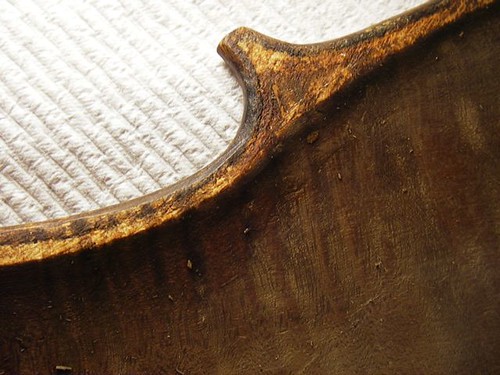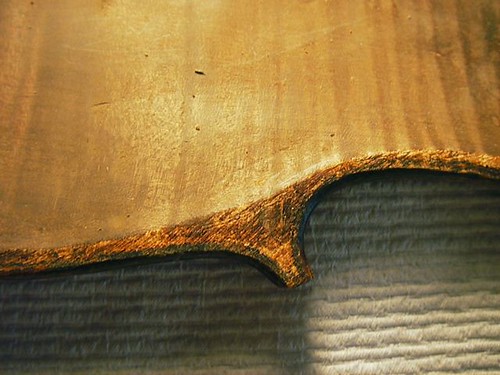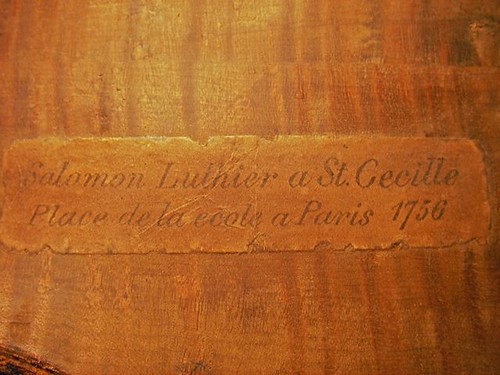Don't know if it will match the back I have for this one, which I think is rather plain, but the ribs are flamed, so a mongrel it will be.
Saturday, March 24, 2012
Squaring a neck.
I was squaring up a block for the neck this morning before breakfast, just getting a little done while waiting for the rest of the house to get going. This was a rather plain looking block, didn't cost all that much, and didn't seem to nice -- but after removing a little wood, it had quite a nice sheen to it, as well as some nice figure.
Thursday, March 22, 2012
One small step -- joining a top.

I have been so busy with work lately that I haven't had a breath of time to work on my own instruments. Today, I finally said to heck with it and joined a top. It has been since the end of November when I've done anything towards my Amati Bros. form -- so now I have a top to work with. Small victory, but still a victory.
Saturday, March 17, 2012
1737 Geometrical Construction Error
I have just started reading “Architecture and Geometry in the Age of the Baroque” by George L. Hersey, which was recommended as another good book into the theoretical mind of the time -- connecting music and architecture.
In the book, on pg 16, is Guarino Guarnini’s scheme for drawing a Golden-section rectangle, published in 1737.
There was a clear typo in the text, where
CH:FH :: FH:FA
should have read
CF:FH :: FH:FA
Or at least it seemed obvious to me, then I wasn’t so sure, so I thought, heck, I’ll just do the construction, then measure and calculate the resulting ratios. I tried it 3 or 4 times. Expecting to get 1.618, I was surprised to get 1.73 or 1.74. What the heck is going on? So I did the quick theoretical calculation -- maybe where I should have started -- and found that the ratio from this construction is actually the square root of 3, or about 1.73.
Guarnini’s method is/was wrong. And here it was being presented in an architecture text written in 2000 as being correct. And then, perhaps, in a subsequent edition, there is a footnote (14) that presents the error, though it is not corrected in the text itself.

Saturday, March 3, 2012
Internal edgework and tool marks
A couple fiddles on the bench right now, that I'm trying to fix up, and not 100% sure that it will come out on either, but they had such different internal work that I thought that was interesting. This first one has a very wide platform inside the plate -- so wide that the sanding marks are still easily seen. Before this top was graduated (the inside scooped out) it was, perhaps, held down on a large belt sander to make a flat surface. You can see it here first as a difference in color from the lighter, rougher flat surface to the more defined cut surface towards the f-hole. Note also the stain which has filtered, or slopped, in through the f-hole, and the yet-to-be-repaired wing crack, located by the penciled circle.
Here's another shot of the wide sanded platform left around the edge. A little closer in, you might be able to better make out the parallel sanding marks.
By contrast, this one has almost no platform. The arching dives sharply away from the edge, making a dark shadow. In some places, a previous repairman noted that the ribs overhung too far inside. To 'fix' this, he shoved some woodputty to fill the gap. This back is also darkly stained and has about a pound of dried hide glue, in gobs all over, which I am slowly removing.
Another shot of the very thin edge. If you think of the external overhang, which you can see the stain of on the corner, then go back in 1 mm for the rib, and say, another 1.5-2 mm for the lining, you can see there's not much wiggle room.
The thin-platform fiddle has, on the other hand, a very interesting fake label!
Inside of the "Salomon" violin, as it was when I removed the back (not hard to do, as it was simply hanging on at a few places. The bass-bar appears to be a recent replacement, reasonably done, a new soundpost, and a dust-ball, which is usually a sign that it's been intact and played for a while. Note also the brown staining to the wood, especially visible on the ribs and end-block. Also not the glue spread everywhere on the top, with much excess at the rib-top joint.
Here's the upper-inside back of the "Salomon" violin. You can notice that the wood that was under the neck block and ribs is relatively white, while the rest of it dark. Also note the area from, say, 1 o'clock to 2 o'clock, where I have removed some excess hide glue. The water I used removed some of the 'age'. This is the same water I use to make my coffee, so maybe it will help keep me younger, too! The stain was added to the inside of this fiddle, along with the label, to deceive people. That's it, pure and simple.
Subscribe to:
Posts (Atom)









